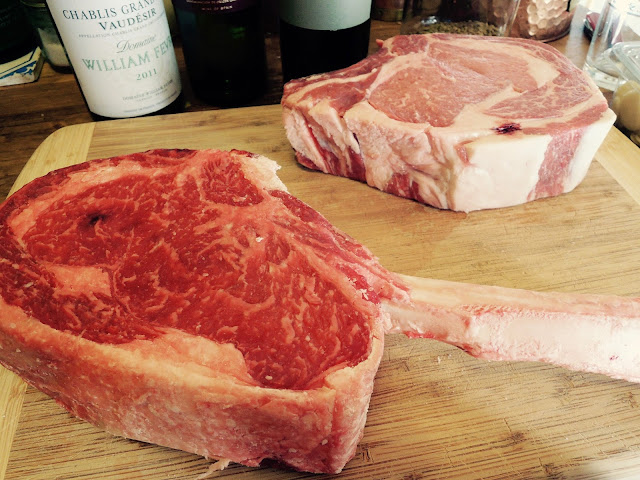OnTheTable: Make the Perfect Christmas Roast
The perfect roast
Christmas is that special time of the year when budgets are busted, diets are denied, and restraints are relinquished—at least until January 1st. So, this leaves you with over two weeks to continue in the epicurean way. Now, On The Table does not officially endorse over-indulgence nor shopping till you’re dropping. But we do endorse an annual loosening of the purse-strings in the pursuit of a fine, Christmas dinner. After all, if you can’t celebrate during the holidays it’s time to re-read (or re-watch) the season’s Dickensian classic.
You’ve agreed to celebrate? Good. Nothing says yuletide cheer like a roast. Thankfully the season of turkey is behind us (a rather unremarkable piece of poultry). That leaves us with America’s favorite: beef.
Which beef to buy?
Only 3% of all beef produced in the States is awarded the USDA’s top grade of “Prime.” Such a honorable badge is based primarily on high levels of marbling and younger cattle. These qualities deliver a tender and flavorful cut of beef, but they also make authentic Prime grade difficult to find.
On The Table was, to our delight, able to procure a Prime grade standing rib roast. But we couldn’t stop there. Knowing how hard it is to find, and not wanting to leave our readers excluded, we asked: Is there a viable alternative to Prime grade?
Callicrate Beef is lauded as the local purveyor of responsibly raised beef. They boast younger, healthier, happier cattle. They also dry age all their beef. The result is, supposedly, superior beef.
Callicrate does not grade their beef as the USDA does. Rather, their beef is either standard grade or the acclaimed, and nearly unobtainable, Wagyu grade. Our luck must have run out in finding the Prime because no Wagyu was available. So, we soldiered on with a standard, Callicrate standing rib roast. And thus we had our competition: USDA Prime v. Callicrate. Could the local talent outgun the national champion?
The Roasting Method
Just as an athlete is handicapped without proper equipment, so it is with meat and method. A $200 rib roast is worthless if poorly prepared. The inevitable shortcoming to most recipes is that they leave you with a gradation of doneness: the crust is charred and the inside fades from grey to pink to a rare-red center. The culprit: too high a heat. Regardless of your preference of doneness, this roasting method (derived from the esteemed, J. Kenji López-Alt, author of the James Beard Award-nominated column, “The Food Lab”), will ensure that your pricey cut of beef is evenly cooked from edge to edge. The key: low and slow heat, and a scorching finish.
Patience and preparation are here rewarded. Purchase you roast days in advance, allowing time for a little “dry-aging.” Place the beef uncovered in your refrigerator for a minimum of an overnight—longer is better. One day in advance of the meal, generously rub all sides with salt; replace in refrigerator. Remove from the refrigerator with enough time to allow the cut come to room temperature.
Make numerous, small incisions into the surface of the roast, inserting rosemary and slivers of garlic; these flavors will permeate the roast during cooking. Place the meat on a rack, in a pan, and into an oven that is set to the lowest possible temperature, e.g., 200F. Insert an oven-safe, alarmed, probe-thermometer that will give you realtime readings of the beef’s internal temperature. Set alarm to 120F (medium-rare), or 135F (medium). Cook time can take up to four hours. Your patience will be rewarded.
Once desired temperature is achieved remove from the oven and let rest under foil for thirty minutes. Just prior to serving create a golden crust via either a blowtorch (fun!), or placing in a 500F oven for approximately 8 minutes—keep an eye on it.
Voilà! The perfect roast, evenly cooked from edge to edge. The science behind why this method works exceptionally well can be explained, but all you need to know is that it works, and if followed will produce the finest Christmas roast you’ve ever had.
And the winner is…
Oh, you wish to know who won the best-beef-battle? They both did. Try as we might, we could not be pressed into distinguishing a superior beef. Both USDA Prime grade and the local Callicrate beef presented flawless roasts worthy of the finest Christmas celebration. After all, it’s hard to improve upon perfection.






Comments
Post a Comment